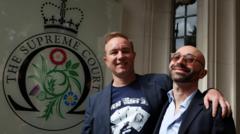What Led to the Quashing of Bankers' Convictions and What's Next?

Understanding Rate-Rigging: The Overturned Convictions of Tom Hayes and Carlo Palombo
The recent decision by the UK's Supreme Court to overturn the convictions of former traders Tom Hayes and Carlo Palombo has reignited discussions around rate-rigging, its implications, and the broader financial landscape. This controversial practice, which involves manipulating interest rates, has far-reaching consequences for borrowers and the financial industry at large. In this article, we will delve into the complexities of rate-rigging, explore the cases of Hayes and Palombo, and consider the implications of their exoneration. By the end, you'll gain a clearer understanding of rate-rigging and its significance in today's financial world.
What is Rate-Rigging?
Rate-rigging refers to the illegal manipulation of interest rates, specifically those that serve as benchmarks for financial transactions between banks. The most notable rates that were affected include the London Interbank Offered Rate (Libor) and the Euro Interbank Offered Rate (Euribor). These rates dictate borrowing costs for various loans, including mortgages, car financing, and commercial loans. When traders manipulate these rates, they can create a distorted market that impacts millions of consumers and businesses.
The practice of rate-rigging can manifest in several ways, including:
- Collusion: Traders from different banks may coordinate to set rates at artificially high or low levels.
- False Reporting: Traders might submit inaccurate data regarding their borrowing costs to influence the benchmark rates.
- Pressure from Superiors: In some cases, traders may feel compelled to engage in rate-rigging due to pressure from their superiors or the culture within their banks.
The Role of Libor and Euribor
Libor and Euribor serve as critical benchmarks in the global financial system. Libor was used extensively in the United Kingdom, while Euribor was more prevalent in the eurozone. Financial institutions relied on these rates to determine the interest they would charge for loans and other financial products. The significance of these rates cannot be overstated, as they influenced trillions of dollars in transactions worldwide.
Following the financial crisis of 2008, it became evident that the integrity of these benchmarks was compromised. The manipulation of Libor and Euribor not only affected individual borrowers but also contributed to a lack of trust in the financial system as a whole. As a result, both rates have undergone significant reforms, with Libor being discontinued and Euribor being overhauled to enhance transparency and reliability.
The Convictions of Hayes and Palombo
Tom Hayes and Carlo Palombo were among the 37 City traders prosecuted for their involvement in manipulating Libor and Euribor. Hayes was accused of being the "ringmaster" of an international conspiracy to influence these rates for the benefit of the banks' trading activities. In 2015, he became the first banker to be jailed for rate-rigging, initially receiving a 14-year sentence, later reduced to 11 years. Palombo, on the other hand, was sentenced to four years in 2019 for his role in the scandal.
While Hayes admitted to attempting to manipulate Libor during his tenure at UBS and Citibank, he contended that such practices were commonplace within the banking industry. He argued that he was being scapegoated for actions that were widely accepted as industry norms. Similarly, Palombo maintained that his conduct was consistent with what was considered acceptable practice at the time.
The Legal Battle and Supreme Court Ruling
Despite serving their sentences and facing significant reputational damage, Hayes and Palombo continued to fight against their convictions. Over the course of a ten-year legal battle, they faced numerous obstacles in their attempts to have their cases heard by the Supreme Court. The Court of Appeal blocked their cases five times between 2015 and 2019, leaving them with limited options for recourse.
However, the Supreme Court ultimately ruled that the trials of Hayes and Palombo were unfair, citing incorrect jury directions as a primary reason for their unsafe convictions. This decision marked a significant turning point in the ongoing saga, as their convictions were overturned, and the Serious Fraud Office announced it would not pursue a retrial.
The Implications of the Overturned Convictions
The exoneration of Hayes and Palombo raises several important questions about accountability in the financial sector. While the traders were prosecuted and jailed for their roles in manipulating interest rates, evidence has emerged indicating that central bankers and government officials played a role in pressuring banks to engage in similar practices on a much larger scale. This raises concerns about the fairness of the legal proceedings and whether they were merely scapegoats in a broader context of financial misconduct.
Moreover, the lack of prosecution against central bankers and government officials stands in stark contrast to the punishments meted out to traders. This discrepancy highlights potential systemic issues within the financial regulatory framework and the need for a reevaluation of how accountability is enforced across the industry.
Future Considerations for Rate-Rigging
The overturning of Hayes and Palombo's convictions may open the door for other traders to seek justice for similar accusations. As the legal landscape surrounding rate-rigging evolves, it is crucial to consider both the ethical and legal implications of such practices. Moving forward, the financial industry must address the following:
- Transparency: Implementing clearer guidelines and regulations to ensure that interest rates are determined fairly and transparently.
- Accountability: Holding all parties, including government officials and central bankers, accountable for any misconduct that may arise.
- Public Trust: Working to restore public confidence in the financial system by demonstrating that unethical practices will not be tolerated.
FAQs About Rate-Rigging and the Hayes and Palombo Cases
What are Libor and Euribor?
Libor (London Interbank Offered Rate) and Euribor (Euro Interbank Offered Rate) are benchmark interest rates that indicate the average rates at which major banks lend to one another. They play a vital role in determining borrowing costs for various financial products.
Why were Hayes and Palombo's convictions overturned?
The Supreme Court ruled that the trials of Hayes and Palombo were unfair due to incorrect jury directions, leading to the conclusion that their convictions were unsafe.
What are the implications of the overturned convictions?
The exoneration raises questions about accountability within the financial sector, particularly concerning the prosecution of traders versus the lack of action against central bankers and government officials who may have pressured them.
How does rate-rigging affect consumers?
Rate-rigging can lead to artificially inflated or deflated interest rates, directly impacting borrowers' costs for mortgages, loans, and other financial products. It undermines the integrity of the financial system and erodes consumer trust.
What reforms are needed to prevent future rate-rigging?
Essential reforms include increasing transparency in rate-setting processes, ensuring accountability for all parties involved, and restoring public trust in the financial system through ethical practices.
The recent developments surrounding Tom Hayes and Carlo Palombo's cases serve as a crucial reminder of the complexities and challenges in the financial sector. As we move forward, it is vital for regulators and industry leaders to ensure that similar injustices do not occur again. How can we work together to promote a more transparent and accountable financial system that serves the interests of all stakeholders? #RateRigging #FinancialJustice #Accountability
Published: 2025-07-23 13:40:07 | Category: technology



